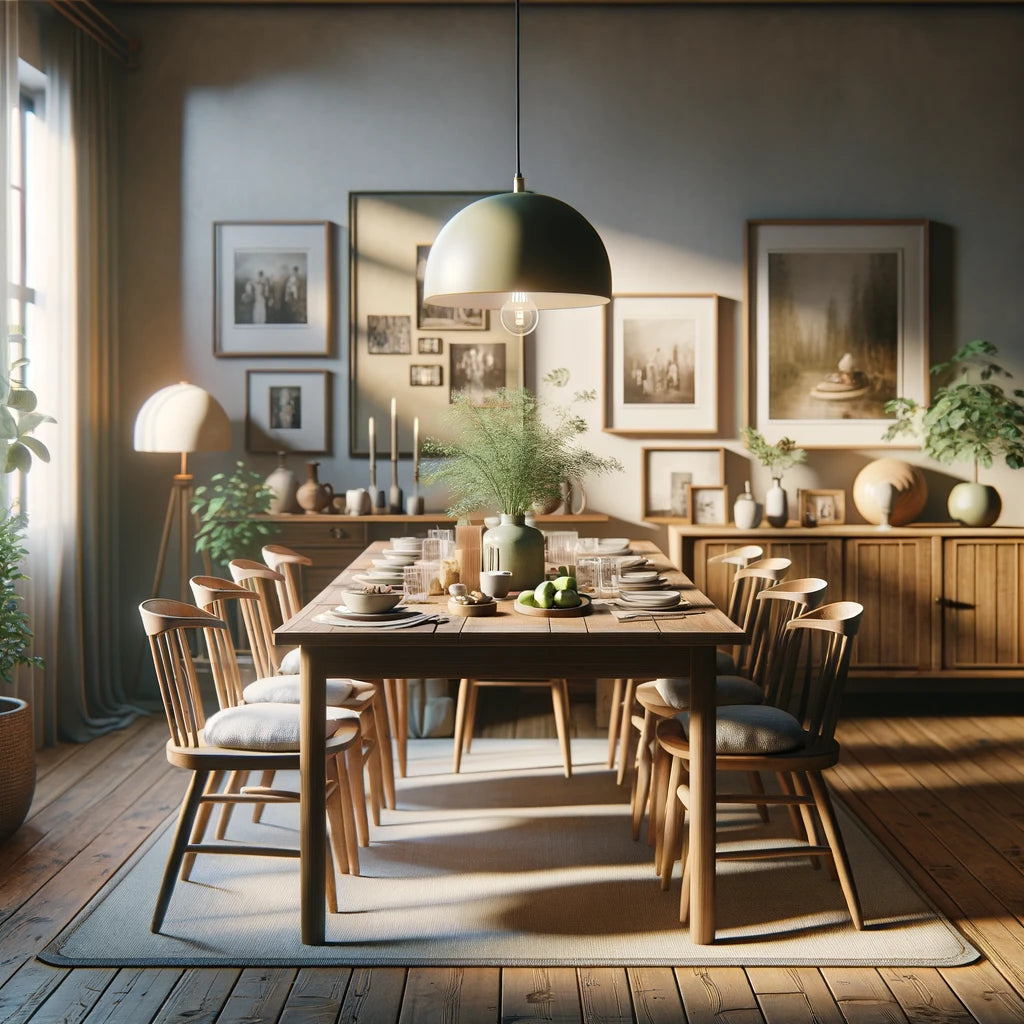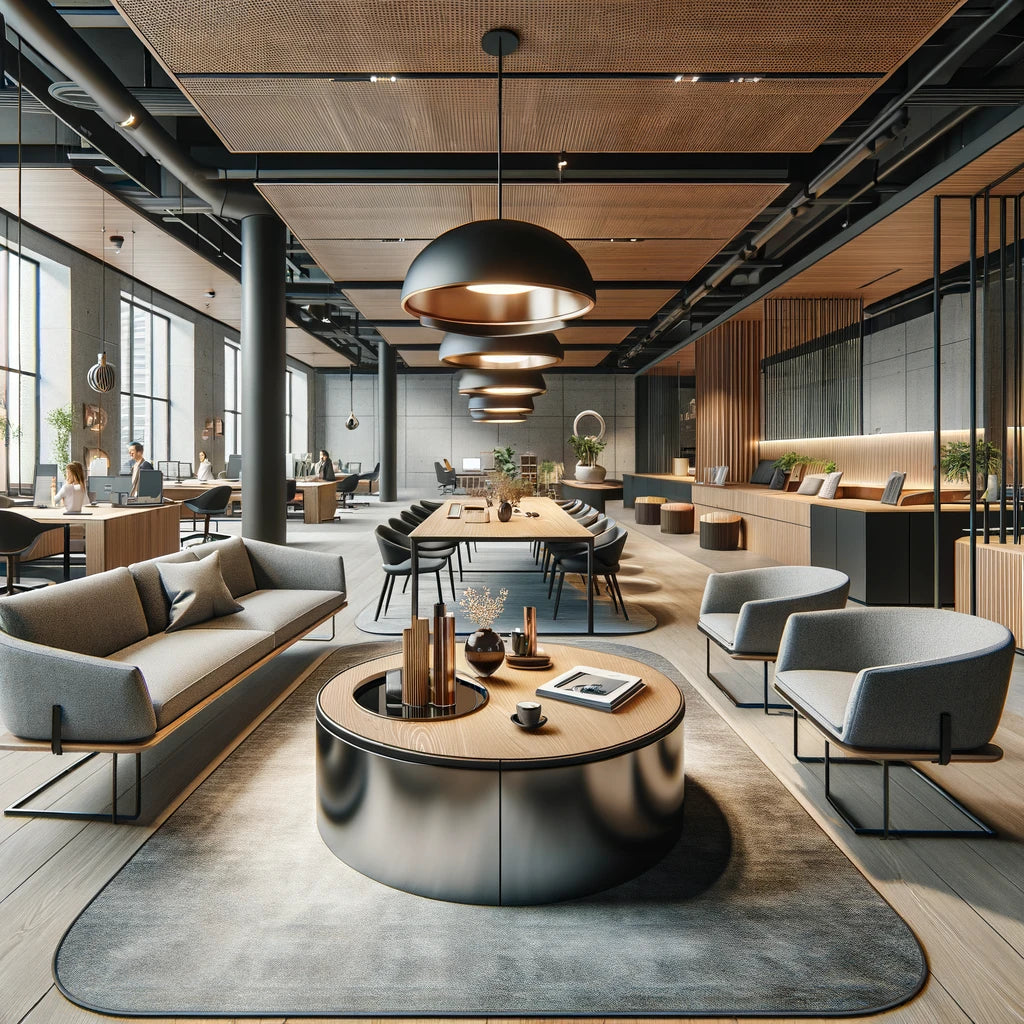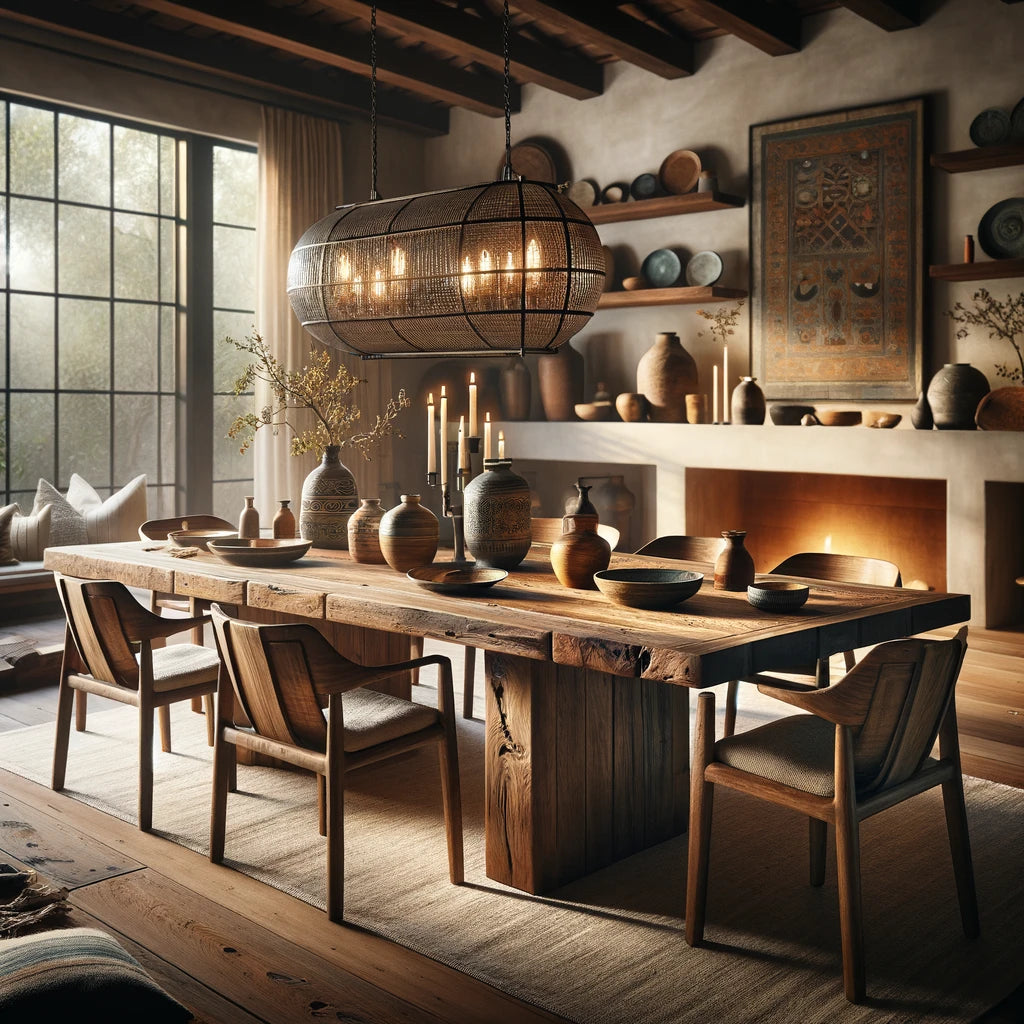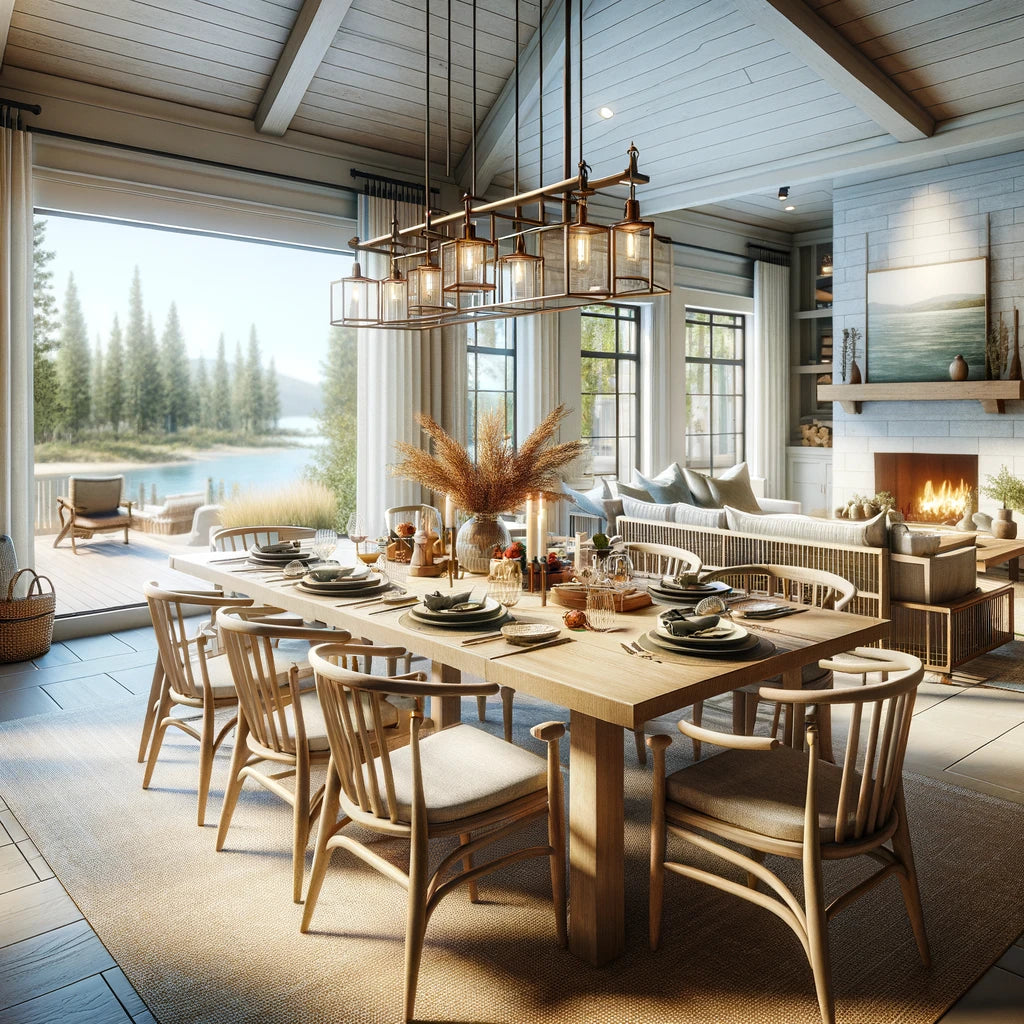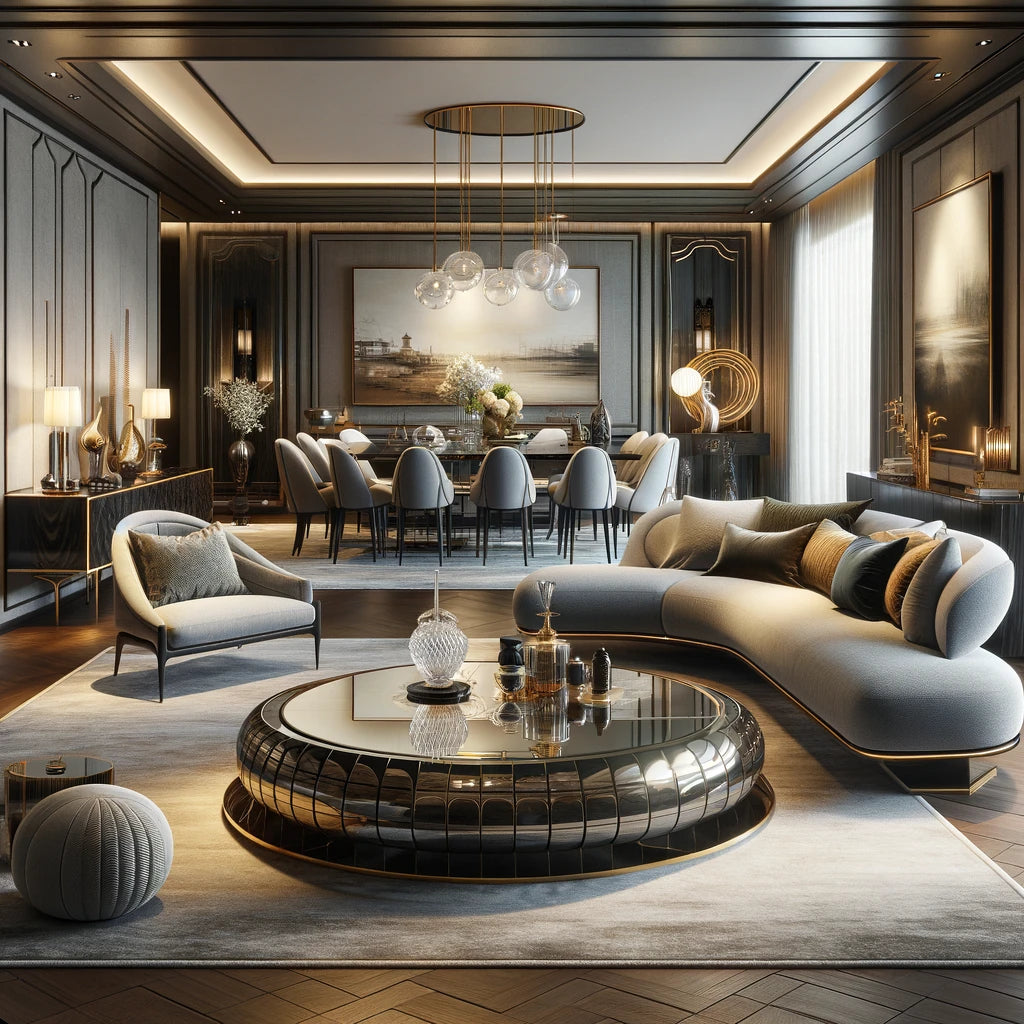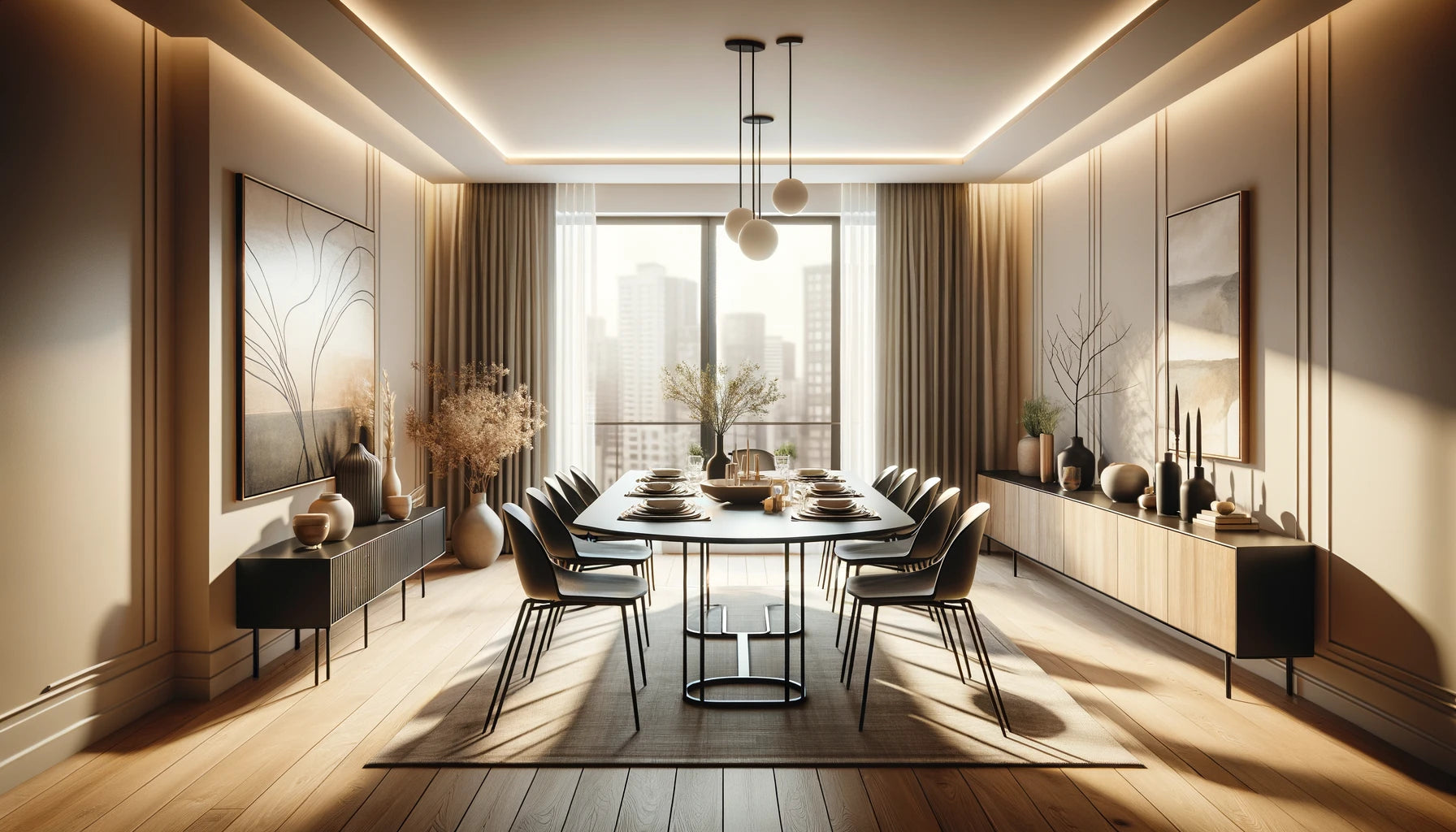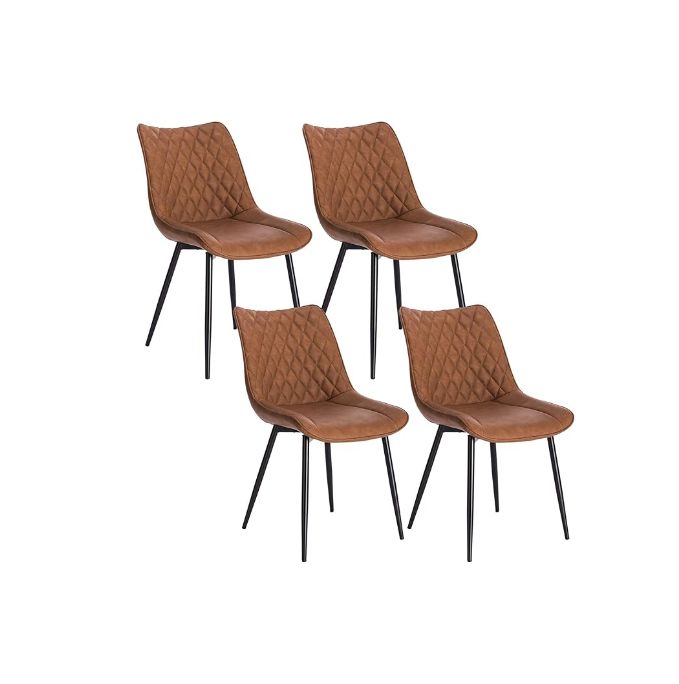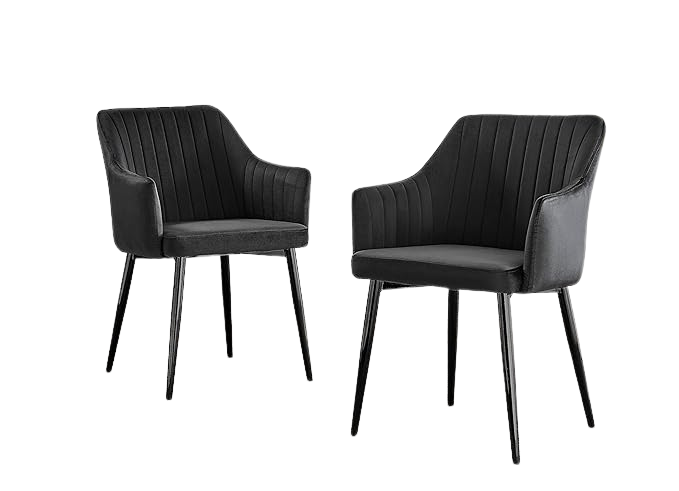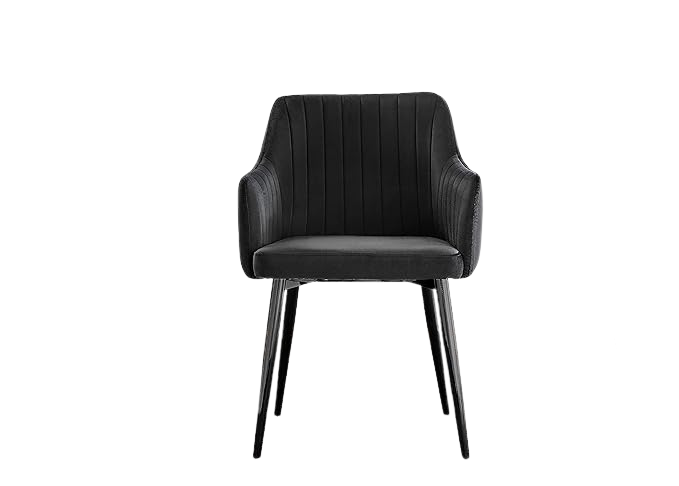When it comes to selecting the perfect table for your living or working space, the choice of materials plays a pivotal role.
The decision between solid wood and veneer tables is not just about aesthetics; it's about embracing sustainability, durability, and mindful consumption. In this article, we'll take you on a journey through the merits of both solid wood and veneer tables, helping you make an informed choice that aligns with your unique needs and environmental consciousness.
Material Matters
When it comes to selecting the perfect table for your space, the choice of materials plays a pivotal role.
Two common options often considered are solid wood and veneer. Each comes with its unique attributes and eco-friendly aspects. In this article, we'll explore the merits of both choices to help you make an informed decision.

Solid Wood Tables: Timeless Durability and Natural Beauty
Solid wood tables, hewn from hardwoods like oak, have a storied history of enduring quality and aesthetic appeal. Here's why they're celebrated:
- Durability: Solid wood tables are renowned for their resilience. Hardwood varieties like oak, maple, and cherry can withstand daily wear and tear, making them ideal for long-lasting furniture.
- Natural Aesthetics: The innate charm of solid wood lies in its distinct grain patterns and textures. Each piece possesses a unique, natural beauty that adds warmth and authenticity to any space.
- Repairability: In the event of damage, solid wood tables can often be repaired and refinished, extending their lifespan and contributing to sustainability.
- Sustainable Sourcing: When responsibly sourced, solid wood tables are an environmentally conscious choice. Sustainable forestry practices ensure that trees are replanted, and forests are managed for minimal environmental impact.

Veneer Tables: Maximising Efficiency and Stability
In recent years, veneer tables have gained popularity for several compelling reasons:
- Resource Efficiency: Veneer tables utilise a thin layer of high-quality wood adhered to a stable core or substrate. This ingenious technique minimises wood consumption, reducing waste and environmental impact.
- Stability: Thanks to their stable core, veneer tables are less susceptible to issues like warping or cracking, especially in environments with fluctuating humidity levels.
- Customisation: Veneer opens up a world of design possibilities. It can be used to create intricate patterns and replicate exotic wood looks that may be impractical or cost-prohibitive with solid wood.
- Sustainability: Just like solid wood, veneer can be eco-friendly when sourced responsibly. Opting for veneer can help reduce the demand for rare or slow-growing hardwoods.
Additional Considerations for Your Decision
- Budget: Veneer tables often present a more budget-friendly option compared to solid wood, making them accessible to a wide range of consumers.
- Maintenance: Both solid wood and veneer tables require regular upkeep, such as cleaning and occasional resealing or refinishing, to ensure their longevity.
- Purpose: Think about how the table will be used. For high-traffic areas or commercial spaces, the durability of solid wood may be preferable. Conversely, veneer can excel in decorative or occasional use scenarios.
In conclusion, your choice between solid wood and veneer tables should align with your unique needs, style preferences, and sustainability goals.
Both options have their own set of merits, and when sourced responsibly, they can contribute to a more environmentally-conscious and aesthetically pleasing living or working environment.
Local Craftsmanship
Local craftsmanship is a valuable aspect of sustainable and responsible consumer choices.
When you choose tables crafted by local artisans, you are not only acquiring a unique and high-quality piece of furniture but also contributing to several important factors that benefit both your community and the environment. Let's delve deeper into the significance of supporting local craftsmanship:
- Economic Benefits: Local artisans and craftsmen are an integral part of your community. By purchasing their products, you are directly supporting their livelihoods and contributing to the growth of the local economy. This means more job opportunities, improved income distribution, and a stronger local financial ecosystem.
- Reduced Carbon Footprint: One of the most immediate benefits of choosing locally crafted tables is the significant reduction in the carbon footprint associated with transportation. When products are made in your region, they do not have to travel long distances via trucks, ships, or planes, which would otherwise release harmful greenhouse gases into the atmosphere. This reduction in transportation emissions helps combat climate change.
- Sustainable Materials and Practices: Local artisans often prioritise sustainable materials and practices. They are more likely to use locally sourced wood and other materials, reducing the environmental impact of harvesting and transportation. Additionally, local craftsmen may implement eco-friendly production methods, such as minimising waste, using non-toxic finishes, and repurposing materials.
- Customisation and Unique Designs: Local artisans often offer customisable options, allowing you to have a say in the design and specifications of your table. This not only ensures that you get a piece of furniture that suits your preferences perfectly but also reduces the likelihood of waste from mass-produced, one-size-fits-all items.
- Preservation of Traditional Skills: Supporting local craftsmanship helps preserve traditional skills and knowledge that are often passed down through generations. These skills are a cultural treasure that contributes to the uniqueness of your region and adds character to the products you purchase.
- Better Quality and Durability: Local artisans tend to take great pride in their work, resulting in higher quality and more durable products. When you invest in a locally crafted table, you can expect it to last longer and potentially save resources in the long run by reducing the need for frequent replacements.
In summary, choosing tables crafted by local artisans is a conscious and responsible choice that not only enhances the aesthetics of your living space but also supports your local economy, reduces environmental impact, and promotes sustainable practices.
It's a win-win situation for you, your community, and the planet. So, the next time you're in the market for furniture, consider the value of local craftsmanship.

Timeless Design
Investing in furniture with a timeless design is a wise and sustainable choice that can have numerous benefits for both your living space and the environment.
Let's explore the concept of timeless design and why it's worth considering when selecting furniture:
- Durability and Longevity: Timeless designs are characterised by their enduring appeal and classic aesthetic. These designs often prioritise quality materials and craftsmanship, which result in furniture that stands the test of time. When you choose a table with a timeless design, you are making an investment in a piece of furniture that is built to last for many years, if not generations. This durability reduces the need for frequent replacements, ultimately saving you money and reducing waste.
- Versatility: Timeless designs are versatile and can seamlessly integrate into a variety of interior styles and décors. Whether your home's style is traditional, contemporary, or somewhere in between, a table with a timeless design can complement your space, making it a versatile and enduring addition to your home. This adaptability ensures that your table remains relevant as your interior preferences evolve over time.
- Reduced Consumerism: One of the most significant advantages of timeless design is its ability to resist fleeting trends. In a world where consumerism often drives us to constantly update our possessions to stay "in fashion," timeless furniture encourages a more sustainable mindset. When you are satisfied with the design of your table for years to come, you are less likely to succumb to the urge to replace it frequently, reducing unnecessary consumption and waste.
- Sustainable Materials: Many timeless designs prioritise the use of sustainable materials. These materials are often chosen for their durability, renewability, and eco-friendliness. By opting for a table with a timeless design, you may be supporting the use of sustainable resources and environmentally responsible production practices.
- Emotional Attachment: Timeless furniture can develop a deeper emotional attachment over time. As your table becomes a part of your family's history, it can hold sentimental value and memories associated with various life events. This emotional connection can make you more inclined to care for and maintain your table, further extending its lifespan.
- Lower Environmental Impact: Choosing furniture with a timeless design contributes to a more sustainable lifestyle. It reduces the demand for new furniture production, which often involves resource-intensive processes and transportation emissions. This, in turn, helps reduce the overall environmental impact associated with the furniture industry.
In conclusion, a table with a timeless design is not just a piece of furniture; it's an investment in long-term satisfaction, sustainability, and a more conscious approach to consumption.
By opting for enduring aesthetics and quality craftsmanship, you can create a living space that remains beautiful and relevant for years, all while minimising your ecological footprint and contributing to a more sustainable future.

Durability & Longevity
When it comes to choosing furniture, durability and longevity are essential factors to consider not only for your own benefit but also for the environment.
A table that is built to last can have a profound impact on reducing its environmental footprint. Let's delve deeper into the importance of durability and longevity in furniture:
- Resource Conservation: Durable tables are made to withstand the test of time. They are constructed with quality materials and craftsmanship, ensuring that they do not wear out or break easily. This longevity means that fewer resources are consumed in the production of replacement tables, ultimately reducing the environmental impact associated with manufacturing, transportation, and disposal of furniture.
- Reduction in Waste: Furniture that is not durable tends to wear out or become damaged relatively quickly, leading to disposal and replacement. This results in the generation of waste, as old tables are discarded and new ones are produced to take their place. In contrast, a durable table can remain functional and aesthetically pleasing for many years, significantly reducing the amount of furniture waste that ends up in landfills.
- Energy and Carbon Savings: The production and transportation of furniture involve significant energy consumption and greenhouse gas emissions. When you invest in a durable table, you contribute to energy and carbon savings over its extended lifespan. Fewer replacements mean fewer manufacturing processes and transportation emissions, helping combat climate change.
- Cost-Effective: While durable tables may have a higher initial cost, they often prove to be more cost-effective in the long run. You'll save money over time by not having to replace your table frequently. This financial benefit aligns with a sustainable and responsible approach to consumption.
- Quality Materials and Craftsmanship: Durable tables are typically crafted with high-quality materials and skilled workmanship. These tables are designed to withstand wear and tear, making them a valuable investment. Quality materials, such as solid wood, metal, or other durable components, contribute to the table's longevity and resistance to damage.
- Customisation and Adaptability: Many durable tables are designed to be adaptable and customisable. This means you can update or modify them as your needs or preferences change, without the need for a complete replacement. This adaptability extends their lifespan and reduces the likelihood of them becoming obsolete.
In summary, choosing a table with durability and longevity in mind is not just a matter of convenience or aesthetics; it is a responsible and eco-conscious decision.
By investing in furniture that can withstand the test of time, you contribute to resource conservation, waste reduction, energy savings, and a more sustainable lifestyle.

Easy Assembly
When it comes to furniture, the ease of assembly is a critical aspect that impacts not only the convenience of the consumer but also the environment.
A table that is designed for straightforward assembly, such as our products, offers several environmental and practical advantages that contribute to sustainability:
- Reduced Energy Consumption: Furniture that is easy to assemble typically requires fewer tools, components, and energy-intensive manufacturing processes. This leads to lower overall energy consumption during production. Additionally, simpler assembly processes often mean that less energy is required for the assembly itself, as consumers can easily put the furniture together without the need for specialised tools or professional assistance.
- Lower Emissions: The transportation of fully assembled furniture can result in higher greenhouse gas emissions due to the bulkier and heavier nature of such items. In contrast, tables that are designed for easy assembly can be packaged in more compact and efficient ways, reducing the volume of shipments and, consequently, transportation emissions. This is especially important in an era where reducing carbon footprints is a top priority for sustainable living.
- Minimised Need for Professional Services: Furniture that requires complex assembly may necessitate professional assembly services. These services often involve the transportation of skilled technicians to your location, which not only adds to the cost but also increases emissions associated with travel. Tables that can be easily assembled by the consumer reduce the need for such services, promoting self-reliance and cost savings.
- Accessibility: Easy assembly also contributes to greater accessibility for a wider range of consumers. Those with limited mobility, space constraints, or minimal DIY skills can benefit from furniture that is designed for straightforward setup. This inclusivity aligns with the principles of sustainability and social responsibility.
- Extended Product Lifespan: Furniture that is easy to assemble is often more user-friendly, encouraging consumers to disassemble and reassemble it as needed. This can be particularly valuable when moving or redecorating, as it reduces the risk of damage during transportation and ensures that your table remains in good condition, extending its lifespan.
- Reduction in Packaging: Furniture that is easy to assemble can be packaged in smaller, more eco-friendly boxes or containers. This not only reduces the amount of packaging material required but also minimises the waste generated when unpacking and assembling the furniture.
In conclusion, easy assembly in furniture design is not just about convenience; it has far-reaching environmental and practical benefits.
Tables that can be easily put together by the consumer help reduce energy consumption, lower emissions, minimise the need for professional services, and promote accessibility. These advantages align with sustainable living principles and contribute to a more eco-conscious and user-friendly approach to furnishing your home. Our tables are thoughtfully designed with easy assembly in mind, ensuring a hassle-free experience for our customers while also supporting sustainability efforts.

Sustainable Finishes
When it comes to selecting furniture, especially tables, the choice of finishes can play a significant role in the overall environmental impact of the product.
Opting for tables finished with eco-friendly wood finishes, such as Osmo Polyx hardwax oil and Osmo Top Oil, can have several important environmental benefits. Let's explore the significance of sustainable finishes:
- Non-Harmful to the Environment: Eco-friendly wood finishes like Osmo Polyx hardwax oil and Osmo Top Oil are formulated with environmentally responsible ingredients. They do not contain harmful chemicals, volatile organic compounds (VOCs), or toxic solvents that can be detrimental to the environment and human health. By choosing these finishes, you reduce the release of pollutants into the air and water, contributing to a cleaner and safer environment.
- Biodegradable and Non-Toxic: Sustainable finishes are often biodegradable and non-toxic, which means that they break down naturally over time without leaving harmful residues in the environment. This characteristic minimises the long-term ecological impact associated with furniture maintenance and disposal.
- Minimal Waste Generation: Furniture finishes that are eco-friendly tend to produce less waste during application and maintenance. They can be applied in thin, even layers, reducing excess material that would otherwise end up as waste. Additionally, eco-friendly finishes are often designed to be easily refreshed or repaired, further reducing the need for complete refinishing and waste generation.
- Long-Lasting Protection: Sustainable finishes not only protect the wood but also contribute to the longevity of your table. They offer durable and resilient coatings that can withstand wear and tear, reducing the frequency of refinishing or replacement. This extended product lifespan is inherently sustainable as it reduces resource consumption.
- Responsibly Sourced Ingredients: Many eco-friendly wood finishes use responsibly sourced raw materials. This includes wood-derived ingredients from sustainable forestry practices, ensuring that the production of the finishes supports responsible land management and biodiversity preservation.
- Support for Sustainable Forestry: By choosing tables finished with eco-friendly products, you indirectly support sustainable forestry practices. Sustainable finishes are often associated with companies that are committed to environmental responsibility throughout their supply chain, from the source of wood to the final product.
- Health and Well-being: Eco-friendly finishes not only benefit the environment but also promote healthier indoor air quality. They emit fewer harmful VOCs, contributing to a more pleasant and safe living environment for you and your family.
In summary, selecting tables finished with eco-friendly wood finishes like Osmo Polyx hardwax oil and Osmo Top Oil is a sustainable choice that aligns with responsible and environmentally conscious living.
These finishes not only protect and beautify your furniture but also minimise harm to the environment, reduce waste, and promote long-term product durability. By making informed choices about the finishes on your furniture, you can contribute to a greener and more sustainable future while enjoying the beauty and functionality of your tables.

Versatility in Styling
A versatile table is a valuable addition to your home, as it can seamlessly adapt to changing interior styles and preferences.
This adaptability not only enhances your creative freedom but also promotes a more sustainable approach to interior design. Let's explore the concept of versatility in styling and its various sustainable implications:
- Reduced Need for Frequent Redecoration: A versatile table can serve as a timeless and foundational piece of furniture that compliments various interior design themes. When you invest in a table that can adapt to different styles, you reduce the need for constant redecoration and furniture replacement. This is a sustainable choice as it minimises resource consumption, waste generation, and the associated environmental impact.
- Extended Product Lifespan: Tables that are versatile in styling often feature neutral or timeless design elements. This longevity ensures that your table remains relevant and functional as your interior preferences evolve over time. Extending the product lifespan in this manner contributes to sustainability by reducing the demand for new furniture production.
- Minimised Furniture Waste: The fast-paced turnover of furniture due to changing interior trends contributes to significant furniture waste. Versatile tables that remain in style for years help combat this issue by reducing the disposal of perfectly functional furniture. This aligns with the principles of a circular economy, where products are designed to be used and reused for as long as possible.
- Sustainable Materials: Many versatile tables are crafted from sustainable materials that prioritise durability and eco-friendliness. This includes the use of responsibly sourced wood, reclaimed materials, or eco-friendly finishes. Sustainable materials not only reduce the environmental impact but also contribute to the longevity of the table.
- Resource Efficiency: Versatile tables are often designed with resource efficiency in mind. They may incorporate modular or adaptable features that allow you to customise the table's sise, shape, or functionality as needed. This efficient use of resources reduces waste and minimises the need for additional furniture pieces.
- Reduced Carbon Footprint: When you select a versatile table, you are making a choice that supports a lower carbon footprint. This is because versatile tables are more likely to remain in use for longer periods, reducing the need for the production and transportation of new furniture items.
- Design Freedom: Versatile tables provide you with design freedom. You can experiment with different styles and aesthetics in your home without the fear of your table clashing with the overall look. This freedom encourages creativity and personalisation in your living space, making it a reflection of your unique style.
In summary, versatility in styling when it comes to tables encourages a sustainable and responsible approach to interior design.
It enables you to make mindful choices that prioritise long-term use, reduce waste, and minimise the environmental impact associated with the furniture industry. By investing in versatile tables, you not only create a more adaptable and aesthetically pleasing living space but also contribute to a more eco-conscious and sustainable future.

Value Over Disposability
Choosing tables that prioritise value and quality over disposability is a key element of responsible and sustainable consumption.
Tables which offer exceptional value and quality, contribute to a more sustainable lifestyle in several significant ways. Let's delve deeper into the concept of valuing furniture over disposability:
- Extended Product Lifespan: Tables that are designed with exceptional quality and value in mind are built to withstand the test of time. They are constructed with durable materials and craftsmanship, ensuring that they remain functional and aesthetically pleasing for many years. This extended product lifespan reduces the need for frequent replacements, which is inherently sustainable as it minimises resource consumption and waste generation.
- Reduction in Furniture Waste: The furniture industry generates a substantial amount of waste due to the disposal of items that are no longer functional or fashionable. Tables that offer exceptional value are less likely to be discarded, reducing the volume of furniture waste in landfills. This aligns with the principles of a circular economy, where products are designed to have a longer life and can be reused or repurposed.
- Cost-Effective Choice: While tables with exceptional value may have a higher initial cost, they often prove to be more cost-effective in the long run. You save money by not having to replace your table frequently, making it a wise investment. This financial benefit reinforces the idea that sustainable choices can also be economically prudent.
- Lower Environmental Impact: When you choose a table with exceptional value and longevity, you indirectly reduce its environmental impact. Fewer replacements mean fewer manufacturing processes, transportation emissions, and resource-intensive activities associated with furniture production. This contributes to a reduction in the overall carbon footprint of your table.
- Quality Materials and Craftsmanship: Tables that prioritise value and quality are typically crafted with high-quality materials and skilled workmanship. These tables are designed to withstand wear and tear, making them a valuable and reliable addition to your home. Quality materials contribute to the table's longevity and resistance to damage.
- Emotional Attachment and Durability: Exceptional tables often develop a deeper emotional attachment over time. As your table becomes a part of your daily life and family gatherings, it can hold sentimental value and memories associated with various life events. This emotional connection can make you more inclined to care for and maintain your table, further extending its lifespan.
In summary, prioritising value and quality over disposability when selecting tables is a sustainable choice that aligns with responsible and environmentally conscious living.
Tables like the Ascot Rose Rustic Oak Veneer Dining Table offer exceptional value, quality, and durability, ensuring that your investment benefits you and the environment. By making thoughtful and enduring choices in furniture, you not only create a more sustainable and aesthetically pleasing living space but also contribute to a more eco-conscious and responsible approach to consumption.

Recycling & Upcycling
Choosing tables made from recycled or upcycled materials is a sustainable and responsible choice that brings numerous environmental benefits.
These tables offer a unique and creative way to give new life to old resources, reduce waste, and minimise the need for virgin materials. Let's delve into the concept of recycling and upcycling in table design and explore their positive impacts on sustainability:
- Waste Reduction: Tables made from recycled or upcycled materials divert waste from landfills and incinerators. Instead of discarding old furniture or materials, these resources are repurposed to create new and functional tables. This approach significantly reduces the amount of waste generated and contributes to a more circular and sustainable economy.
- Conservation of Resources: Using recycled or upcycled materials in table design conserves natural resources. It reduces the need for harvesting or extracting raw materials, such as timber, metals, or plastics, which can have adverse environmental impacts like deforestation or habitat disruption. By reusing existing materials, you help protect natural ecosystems and reduce resource depletion.
- Energy Savings: The production of virgin materials and furniture components consumes significant energy. When you choose tables made from recycled or upcycled materials, you are indirectly reducing the energy required for resource extraction, processing, and transportation. This translates into lower carbon emissions and a smaller environmental footprint.
- Creative Design Opportunities: Recycling and upcycling often result in unique and visually appealing designs. Tables created from reclaimed wood, salvaged metal, or repurposed materials can showcase character and history, making them one-of-a-kind pieces that add intrigue and style to your living space.
- Encouragement of Sustainable Practices: Supporting furniture made from recycled or upcycled materials encourages sustainable practices in the design and manufacturing industry. It sends a clear message to manufacturers that there is a demand for eco-friendly and resource-efficient products, incentivising them to prioritise sustainable production methods.
- Reduced Environmental Impact: Tables made from recycled or upcycled materials typically have a lower environmental impact throughout their lifecycle. This includes not only the production phase but also transportation and disposal. With fewer emissions and less waste associated with these tables, you contribute to a greener and more sustainable world.
- Promotes a Circular Economy: Recycling and upcycling are integral components of a circular economy, where products are designed to be reused, repaired, or repurposed rather than discarded after their initial use. By choosing tables made from recycled materials, you actively participate in this shift towards a more sustainable and resource-efficient economic model.
In conclusion, selecting tables made from recycled or upcycled materials is a responsible and eco-conscious choice that aligns with sustainable living principles.
These tables not only offer unique and aesthetically pleasing designs but also contribute to waste reduction, resource conservation, energy savings, and a lower environmental impact. By incorporating recycled and upcycled furniture into your living space, you play a part in fostering a more sustainable future and supporting responsible consumption practices.

Reclaimed Wood
Tables made from reclaimed wood are a remarkable example of sustainable furniture design that not only contributes to environmental conservation but also showcases the inherent beauty and character of repurposed materials.
These tables hold numerous benefits, both in terms of sustainability and aesthetic appeal. Let's explore the concept of reclaimed wood in table design and its positive impacts:
- Resource Conservation: Reclaimed wood tables play a significant role in reducing the demand for new tree harvesting. By salvaging timber from old structures, barns, or discarded furniture, these tables prevent the depletion of forests and natural ecosystems. This conservation of trees helps maintain biodiversity, soil quality, and carbon sequestration, all of which are crucial for a sustainable environment.
- Waste Reduction: One of the most substantial advantages of reclaimed wood tables is their contribution to waste reduction. Many old wooden structures or furniture items are destined for disposal. By repurposing this wood, these tables divert valuable materials from ending up in landfills, reducing the environmental burden of waste disposal.
- Lower Carbon Footprint: The production of reclaimed wood tables typically has a lower carbon footprint compared to tables made from newly harvested timber. This is because the energy and emissions associated with cutting, processing, and transporting virgin wood are avoided. Additionally, using reclaimed wood can sequester carbon dioxide and reduce the overall impact of the table's lifecycle.
- Unique Aesthetic: Reclaimed wood tables often feature distinct and visually appealing characteristics. The natural patina, weathering, and imperfections in reclaimed wood tell a story of its previous life and add a rustic or vintage charm to the table. Each piece of reclaimed wood is unique, making every table a one-of-a-kind statement piece.
- Historical and Cultural Value: Tables made from reclaimed wood can have historical and cultural significance. The wood may come from old buildings or structures with rich histories, adding depth and meaning to your furniture. It allows you to incorporate a piece of the past into your contemporary living space.
- Promotes Sustainable Practices: The popularity of reclaimed wood tables encourages sustainable practices in the forestry and construction industries. It sends a clear message that there is a demand for eco-friendly and resource-efficient products, promoting responsible sourcing and repurposing of materials.
- Versatile Styling: Reclaimed wood tables are versatile in terms of styling. They can complement a wide range of interior design themes, from rustic and farmhouse to modern and industrial. This versatility ensures that your table remains relevant and adaptable as your interior preferences change over time.
In summary, choosing tables made from reclaimed wood is a sustainable and environmentally responsible choice that not only reduces the demand for new tree harvesting but also showcases the unique beauty and character of repurposed materials.
These tables exemplify the principles of sustainability, waste reduction, and responsible consumption while adding a touch of history and individuality to your living space. By incorporating reclaimed wood furniture into your home, you contribute to a greener and more sustainable future.

Conclusion
In conclusion, your choice between solid wood and veneer tables should be a thoughtful reflection of your individual preferences, budget, and sustainability goals.
Both options offer distinct advantages that contribute to a more environmentally-conscious living or working environment. The path to sustainable furniture starts with understanding the materials you choose and recognising their impact on our planet. Whether you opt for the timeless durability of solid wood or the resource-efficient stability of veneer, your decision matters in shaping a more sustainable future. So, go ahead, select your table wisely, and let your furniture stand as a testament to your commitment to a greener and more responsible lifestyle.



